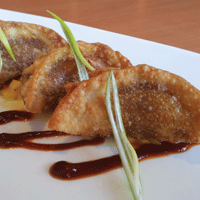Every night between 5 and 6 p.m. snow, rain or shine, young professionals quietly form a line outside a locked door on a far-from-trendy stretch of Toronto’s Queen Street West for a chance to devour Grand Electric chef Colin Tooke’s $3.50 mini tortillas topped with pineapple-studded nuggets of crisp pork belly or a slice of soft pigtail meat, washed down with a vanilla bourbon sour.
Sunday nights in the northwest neighbourhood of Montgomery, Calgarians line up outside Notable for fresh-hewn slabs of Michael Noble’s succulent porchetta ($29), carved from a Spragg Farms pork loin and belly that have been stuffed, rolled and roasted in a clamshell basket spit for three hours over a cherry, apple and birch hardwood fire.
At five-month-old Fat Dragon on Vancouver’s east side, meanwhile, four to five diners a week wait up to an hour for their smoked half a pig’s head ($45) to be roasted to order. “Generally people get fired up about it and don’t mind waiting,” says Ted Anderson, co-owner and executive chef, whose Smoked Pig’s Snout Fried Rice ($15) is a big seller, and whose favourite pâté features pig ears, brains, heart and liver studded with bits of tongue. “When it comes to the table they go to town on it.”Fired up over pig’s head? Hog-wild over belly fat and pigtails? Welcome to a new side of pork, which is hogging the spotlight and attracting a generation of diners willing to try anything at a trendy restaurant, even if it’s just for bragging rights.
At Joe Beef in Montreal, chef Fred Morin rolls and ties pig skin and braises it in tomato sauce. Back on the cutting board, it’s sliced paper-thin like pancetta and comes apart like noodles. Morin’s Pig-Skin Spaghetti ($15) has even become a signature dish at Incanto in San Francisco.
Though he loves using Quebec pork, David McMillan, Joe Beef’s co-owner, is getting fed up with pork in restaurants. “There are too many young chefs doing too many charcuterie boards,” says McMillan. “Every restaurant wants to give me a board of crap-salted pig parts I wouldn’t usually eat.”
While North American chefs’ obsession with specialty cuts such as jowls, cheek meat and belly is fairly new, Mary Jane Quinn, senior marketing communications leader for Ontario Pork in Guelph, notes head-to-tail dining has been popular in other parts of the world for centuries. “The attraction is the amazing flavours, textures and aromas that can be produced from many of these under-utilized cuts,” says Quinn.
On the whole, Quinn says Canadian pork consumption is losing ground to beef and chicken, dropping from 26.6 kg per capita in 2007 to 23.8 kg in 2012. Likewise, Chicago-based Technomic Inc.’s 2011 “Canadian Centre-of-the-Plate” study, tracking beef and pork consumer trends, shows pork entrées have decreased slightly at limited- and full-service restaurants in the past four years.
Bacon
Away from the centre of the plate, however, pork continues to grow in popularity. Since 2008, breakfast side items have included more pork, according to the Technomic study. About a fifth of those polled said they purchase pork at a quick-service restaurant at least once a week, usually as a breakfast or sandwich ingredient. It makes sense. Eggs and pork remain inseparable, and bacon has turned into its own food group, evolving from an egg essential to a topping for cupcakes. The survey shows salads are sporting more crumbled smoked bacon or diced ham, and pasta dishes are showcasing bacon, prosciutto, pancetta and guanciale, prepared from the pig’s jowl or cheeks.
Executive chef Steve Silvestro, hired two years ago to bring authentic Italian dishes to the Burlington, Ont.-based Alice Fazooli’s chain, agrees the “beautiful” guanciale he buys, from butcher Mario Pingue of Niagara Food Specialties, isn’t the most cost-effective meat he could use for his Spaghetti Amatri-ciana ($14.95), but his grandmother would be proud. “It has been well-received and staff really enjoy explaining what cured pork jowl is,” he says.
Bacon-topped burgers, meanwhile, are big business. In fact, more than two in five pork consumers surveyed say they’re willing to spend extra for bacon on their sandwiches.
Cameron Loopstra, senior marketing manager at the Toronto-based Burger King, has high hopes for the Maple BBQ Whopper introduced in May. It features three thick half strips of hardwood-smoked bacon and costs $1.60 more than a regular $4.69 Whopper.
He says customers are also lovin’ BK’s poutine with bacon ($3.99), introduced last fall. “Bacon is one of the most popular taste profiles among restaurant guests,” says Loopstra. “People are asking for it.”
Loopstra confirms more pork will be gracing Burger King’s Canadian menus this year. No word yet if that includes the BK ice-cream sundae garnished with a crisp bacon slice, the subject of an American blogging frenzy.
Pulled Pork
Sandwiches highlighting pork are growing in popularity, particularly at lunch. “Pork sandwiches are a growth category to watch,” note Technomic’s study authors. Sandwiches stuffed with barbecue and/or pulled pork have increased on limited-service restaurant menus since 2008, they say, while other deli-style pork sandwiches have decreased. Seems it’s goodbye ham and cheese and hello pulled pork, in everything.
When the Toronto-based New York Fries quick-service chain added butter chicken and braised beef to its classic poutine a year ago, sales jumped from 50 to 60 per cent overnight, says Jay Gould, president. And, now, NYF’s new pulled-pork topping ($4.99/$5.99) has already raised poutine sales by another two per cent. Gould describes the new offering as slow-cooked Canadian pork with a smoky — not sweet — chipotle finish, served over fresh-cut fries and real Quebec cheese curds. “Once you put meat on fries and cheese curds, you have a meal,” he says. “You don’t need pizza.”
Joe Beef also offers a pulled-pork dish called Truckstopham. “It’s homage to the pork meat loaf you find in cool truck stops between Montreal and New York City,” says co-owner McMillan. He roasts a whole suckling pig over charcoal, shreds the meat, seasons it and presses it into a terrine mould. Roasted slices are served with a slice of fresh pineapple ($25).
At the Mississauga, Ont.-based Mucho Burrito, sales of burritos stuffed with classic pork carnitas ($6-$8) jumped three per cent between 2010 and 2011. “It was probably the biggest shift on the menu,” says Sean Black, executive vice-president of Development for Extreme Brandz, the chain’s parent company, which owns 56 burrito shops and plans to open 23 more this year. “When people realize it’s slow-cooked pulled pork, they get excited,” says Black, adding that pork burritos represents 16 per cent of Mucho’s menu sales. “Once people try the carnitas,” he says, “they always order it again.” That’s good news for the bottom line, he says, since pork is one of the best margin items on Mucho’s menu. “We’re after the best-tasting, most tender product at a reasonable price.”
Pulled pork is also being deep-fried. Chef Jacky Lo, at Toronto’s west-end Lardon, stuffs round wonton wrappers with pulled-pork shoulder before deep-frying them. The potstickers ($9) arrive drizzled with mango-cilantro salsa and homemade barbecue sauce. Apprentices at Notable, meanwhile, spend hours wrapping thin steamed russet potato slices around savoury pulled pork. It’s made from pork butts cooked overnight in the oven and finished with jalapeño jack cheese. When ordered, the potato cigars ($11) are deep-fried and stacked six to a plate, drizzled with spicy ranch dressing and topped with diced avocado and crumbled goat feta.
Porchetta
A taste for porchetta, the seasoned pork roast sold from trailers in Italian markets, is pulling pork in yet another direction. After cooking at some of Toronto’s finest restaurants, chef Nick Auf der Maur opened Porchetta & Co. in a slowly gentrifying area of the city in 2010. He marinates a pork shoulder up to three days in rosemary, sage, garlic and lemon zest, wraps it in thin-sliced prosciutto from a local artisanal butcher and bundles the log in a cured pork belly. The trussed roast is slow-roasted and served on a sourdough bun in chunks, with bits of burnished crackling, (4 oz. for $6.45).
At Notable, chef Noble makes a different porchetta stuffing every Sunday. A recent mixture included Meyer lemons, charred fennel, mustard and roasted garlic ($29).
With today’s emphasis on slow-cooked fatty cuts, it’s easy to forget pork can also be a lean meat, a fact health-conscious diners appreciate. Technomic found that pork tenderloin is significantly more popular today than it was in 2008.
This comes as no surprise to Geir Simensen, owner and chef at the 100-seat Saege Bistro in Halifax. The toque’s customers love his Curried Pork Tenderloin ($21), rubbed with curry spices, finished in coconut cream with bacon and served on jasmine rice with sweet peas and apple chutney. “Tenderloin is a really nice cut of meat to cook because I can cook it whole, let it rest, then slice it and put it on the plate,” says Simensen. “The advantage is it’s just cooked, and it doesn’t have to hold too long.”
The well-travelled chef says he doesn’t feel the need to seek out expensive heritage breeds, such as Berkshire and Tamworth, though he’d never buy “factory” pork. “I enjoy our Nova Scotia pork,” he says. “It allows us to be creative and serve it at a price that works for our clientele. They can’t afford to spend $35 on a pork entrée, and we like people to come here often.” And, if his curried pork tenderloin is as good as it sounds, it’s a sure bet they’ll keep returning, like the customers who line up for pigtail tacos at Toronto’s Grand Electric.
Keep Reading
Hyatt Launches “Thoughtfully-Sourced” Food Program




















